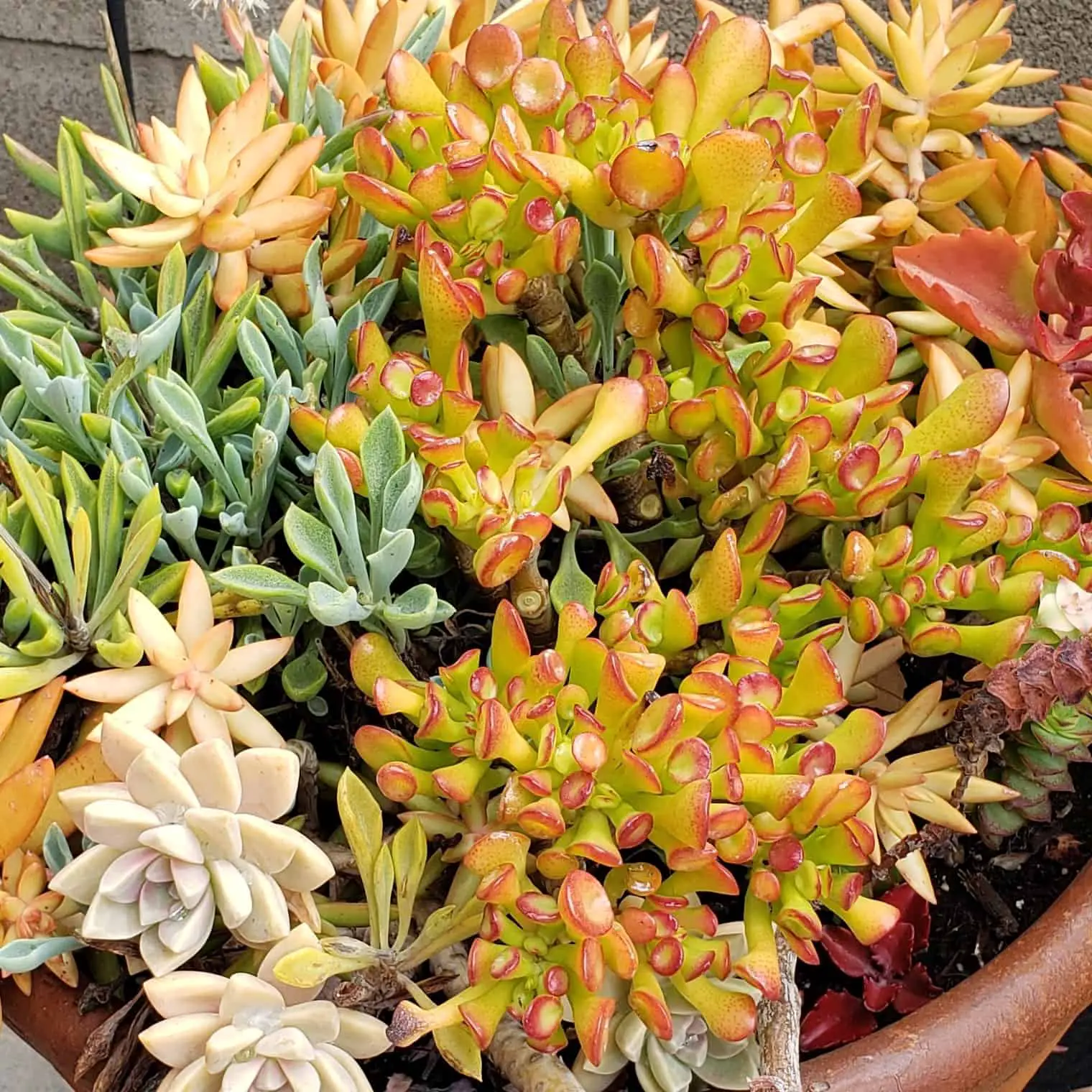You do not have to have a large yard to create an impressive garden. Balcony gardens are a great way for apartment dwellers to show off their green thumbs while being creative. Succulents make a great addition to balcony gardens as they provide visual interest due to their vibrant colors and interesting shapes. In addition, succulents can give your balcony garden a contemporary look. And because succulents are also relatively low maintenance, they are great plants for busy people.
The list below is comprised of some succulents you may want to consider adding to your balcony garden.
Flapjack
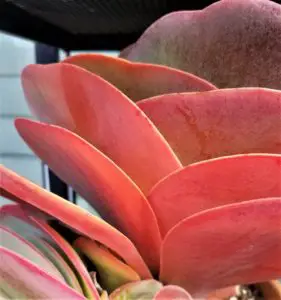
Kalanchoe luciae, which are commonly known as paddle plant or flapjacks, have smooth flat leaves that turn a beautiful red hue when exposed to enough sunlight. Their funky shape and beautiful color make the flapjack a great addition to any succulent garden.
When you water your Flapjacks, it is best to water thoroughly. Then allow the soil to dry completely before watering again.
These plants are not cold hardy. If you live in an area that gets colder than 20°F, it is best to grow this type of succulent in a container that you can bring inside during the winter.
Flapjacks grow well in full sun or partial sun. However, too much intense sunlight will burn the leaves. To achieve the red color that makes flapjack so popular, place your plant in a sunny area. This process is called stressing the plant. If the leaves of your flapjack turn a gray color, the plant is experiencing too much stress.
Drooping, green leaves are an indication that your Flapjack is not getting enough light. Move your plant to a sunnier area.
It is possible to propagate flapjacks from leaves, but it can be difficult. The procedure for propagating from leaves is similar to other plants. However, it is absolutely crucial to pull the leaves off of the stem in such a way that no leaf is left on the stem. You can also grow flapjacks from cuttings.
Firesticks
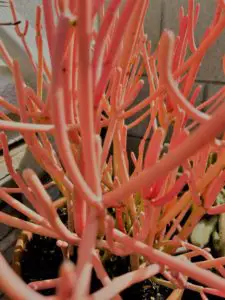
Euphorbia tirucalli, commonly known as fire sticks, are shrubby succulents comprised of thin stems that are pink and green in color. They almost look like coral and will give your succulent garden a more exotic look.
Firesticks have watering needs that are typical of succulents. Water them more often during the spring and summertime (once a week). Allow the soil to dry between waterings. During the winter, decrease the watering frequency to once a month.
Plant your firesticks in an area that receives at least four to six hours of bright sunlight each day. Like other species of succulents, the red/orange colors on your firesticks will be more pronounced when placed in more intense sunlight.
Firesticks will grow up to 8-feet-tall and 5-feet-wide. As long as you continue to plant your firesticks in larger pots, they will keep getting bigger. When they grow into larger bushes, firesticks form woody trunks.
Another great aspect of firesticks is that they are resistant to pests like deer and rabbits. These animals do not like the taste of firestick sap.
I recommend wearing gloves when handling your firestick plant. The sap from these succulents can irritate the skin. Do not touch your eyes after handling these plants as the sap can cause severe burning to the eyes.
Firesticks can be easily propagated from cuttings. Simply cut off a healthy stem with a sharp knife. Then soak the ends in a container of cold water until the flow of sap stops. Finally, plant the cuttings in well-draining soil.
Burro’s Tail

Burro’s tail (Sedum morganianum) is a species of succulent that produces long, trailing stems. They are native to Mexico. As a result, they look really stunning in hanging baskets.
Burro’s tail produces tiny flowers seasonally. These flowers may be red, white, or yellow depending on the cultivar.
Unfortunately, these succulents are fragile. They drop leaves easily. Every time you pick up the plant or water it, some leaves may tall off. For this reason, it is best to avoid repotting the plant.
Fortunately, burro’s tail can be easily propagated from leaves. Simply place any fallen leaves on top of the soil and they will root themselves naturally.
During the spring and summer, water your burro’s tail weekly. During the wintertime, water your burro’s tail once a month. Overwatering will cause the roots to rot.
Burro’s tail likes bright shade or partial sunlight. To maintain the lovely blue-green color that is characteristic of burro’s tail, make sure you place these plants in an area that does not get too much sunlight. If your burro’s tail becomes a pale green or yellow color, your plant is probably being exposed to too much sunlight.
Golden Sedum

Sedum is a large genus of flowering succulents within the Crassulaceae family. It is comprised of nearly 600 species of succulents with varying heights, colors, and shapes. They can be grown in USDA hardiness zones four through nine.
My favorite succulent in the sedum genus is the golden sedum (Sedum kamtschaticum) because the colors are very striking. They are are a low-growing succulent that has many rosettes on each stem. Golden sedums grow very quickly and produce tiny, yellow flowers. If planted in the ground, golden sedums require almost no maintenance.
Golden sedums can survive in partial shade, but they do best in full sunlight. During hot summer weather, make sure these succulents are in an area that is not exposed to aggressive sunlight in order to prevent leaf burn.
Like other succulents belonging to the Sedum genus, golden sedums will lose some of their color if they are not getting enough light. If the leaves of your golden sedum start to fade to green, place your plant in a sunnier location.
During the spring and summer, water golden sedums thoroughly every week or two if they are growing in a location that does not receive any rainfall. Allow the top inch of soil to dry completely between waterings. During the winter, you should only start to water your golden sedum if the leaves start to pucker.
Gollum Jade
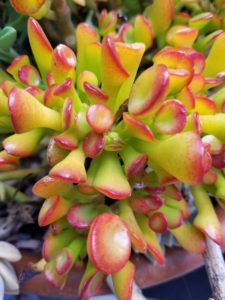
Carassula ovata ‘Gollum,’ which is also known as Gollum jade or finger jade, is a plant with tubular green leaves with red tips. As you may have guessed, these plants are named for the character in JRR Tolkein’s Lord of the Rings books. Gollum jade will produce little pink flowers during late fall and early winter.
Water your Gollum jade once a week during the spring and summer months. Allow the soil to completely dry out between waterings. Cut back on watering in the fall and water very infrequently during the winter (once every month or two).
This species of succulent is very sensitive to overwatering, so it is better to err on the side of under-watering. Plant your Gollum jade in a pot containing well-draining soil. Ideally, use a mixture of cactus soil and perlite.
Gollum jade will do well in partial sun and full sun. When exposed to more sunlight, the leaves will turn a lime green color and have more pronounced red tips. In shadier conditions, the leaves will turn a deeper green color.
Gollum jade can survive colder temperatures (30°F – 40°F) and even mild frost for short periods of time. If you live in an area that is within USDA hardiness zones 9 or 10, you may be able to leave your Gollum jade plants outdoors all year.
Once Gollum jade is mature, it is easy to propagate it from stem cuttings. Simply obtain a stem cutting and allow it to dry for a day or so. Dip the end of the stem in rooting hormone and place the stem in well-draining soil.
Gollum jade is toxic to dogs and cats. It can cause vomiting. In addition, these plants are mildly toxic to humans. If ingested, it can cause diarrhea and vomiting. For these reasons, keep Gollum jade plants out of the reach of children and pets.
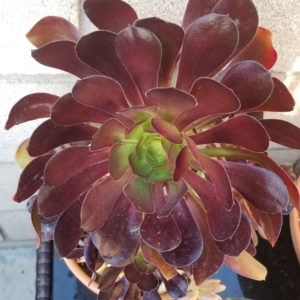
Aeonium black rose Zwartkop, which is commonly known as the black rose aeonium, is a succulent with large burgundy leaves that look like flower petals. The center of the plant is usually a lighter color of green. During the wintertime, they will produce yellow flowers.
Black rose aeoniums can be grown in USDA hardiness zones 9 through 11. These succulents can remain outdoors year-round.
Black rose aeonium can survive in full sunlight or partial sunlight. However, they will only turn dark in color if they are exposed to bright sunlight. Like other succulents, the leaves will burn if exposed to sunlight that is too intense.
These plants should be grown in larger containers (ideally 3-gallons are larger). They prefer to grow in soil with a pH between 5.6 and 7.3. The soil should also be grown in a well-draining soil as they are susceptible to root rot.
Black rose aeoniums do not require fertilizer. However, if you want your plant to grow a little faster, you can apply a balanced, water-soluble fertilizer during the spring and fall growing seasons.
Black rose aeonium is not toxic to humans or dogs.
Echeveria
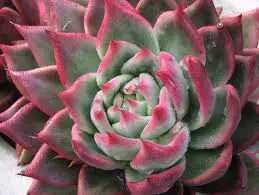
Echeveria is a large genus of rose-shaped succulents in the Crassulaceae family. They are among the most popular types of succulents and come in a wide variety of colors. Most species grow to be a few inches across. They can be grown in USDA hardiness zones 9 through 11.
During the warmer months, water your Echeveria thoroughly once every week or two. Allow the soil to completely dry between waterings. Reduce water during the winter months. Never allow water to sit in the rosette as this can cause rot or fungal disease.
Echeveria succulents like bright, indirect light. They do well in full sun or partial sun. However, these succulents are not cold hardy. Be sure to bring it back indoors when nighttime temperatures drop to 55°F.
It is typically easier to propagate Echeveria from leaf cuttings rather than stem cuttings. Simply place lead in a dish that contains some well-draining soil. Then cover the dish until the leaf sprouts.
Make sure you remove the dead leaves from the bottom of the plant. These dead leaves attract pests like mealy bugs.
String of Pearls
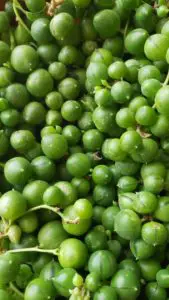
Senecio rowleyanus, which is commonly known as string of pearls, is a flowering plant that is a member of the daisy family Asteraceae. These gorgeous, cascading succulents look stunning in a hanging basket and add a little flair to any home decor. String pearls produce white flowers that smell like cinnamon.
You can grow string of pearls outdoors in hardiness zones 9 through 12. These plants thrive in warmer temperatures (above 70°F) during the spring and summer and temperatures as low as 40°F in the fall. To encourage the growth of flowers, cut back on watering during the winter months and move your string of pearls to a cool area (around 60°F).
Place your string of pearls in an area that is exposed to bright morning light. However, you should take care not to place your string of pearls in an area that is too sunny because the leaves of these plants burn easily.
Like most succulents, string of pearls are drought tolerant. You only need to water them once every one to two weeks. When you water, soak the soil thoroughly. Allow the top 1/2 of soil to completely dry between waterings.
String of pearls grow quickly and are easy to propagate. Simply take some stem cuttings and put the leaves in moist soil. The leaves should root quickly.
Sempervivum
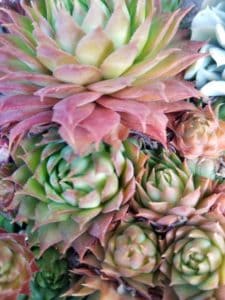
Sempervivum, commonly known as Hens and Chicks, is a type of succulent that produces a mat of rosette-forming plants. They only grow to be a few inches tall which makes these plants an ideal ground cover. The main (large) plant is the “hen” and the offshoots are the “chicks.” The hen passes nutrients along to each chick, and each chick begins to form roots of their own.
These succulents are very hardy plants and can be grown in USDA zones 3 through 10.
While many succulents are native to southern Africa, Sempervivum succulents are native to Europe. They were once planted on thatched rooves to slow down fires. In addition, Sempervivum has also been used for medicinal purposes and witchcraft.
Sempervivum thrives in well-draining soil. They can be grown in sand, gritty soil, or rocks. They can grow in areas with almost no soil like rocky crevices.
Once established, Sempervivum succulents require almost no maintenance. Water them once per week during the driest parts of the year. It is best to water during the summer and prevents beads of water from magnifying the afternoon sun and burning the leaves. During other parts of the year, water more infrequently. Mushy leaves are a sign of overwatering.
Sempervivum can be easily propagated by dividing the chicks (offsets) during the spring or early summer.
Elephant Bush
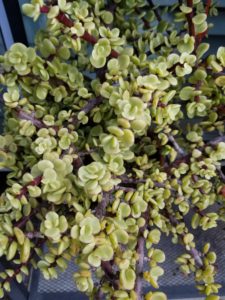
Portulacaria afra, also known as Elephant Bush, are large, bushy succulents that make a perfect addition to any outdoor succulent garden. This plant is sometimes called “Minature Jade.” However, it is not related to Crassula ovata. It is a succulent that is commonly converted to bonsai. In southern Africa, these plants are added to stews and salads.
Elephant bush can be propagated from cuttings using a clean, sharp knife. Allow the stem to callous over before planting in well-draining soil. Only water after the soil dries out completely.
Like other succulents, these plants do best in an area that gets at least 6 hours of sunlight per day. When they are not exposed to enough sunlight, these plants will start to stretch and become leggy. However, the stretching is not as obvious as other types of succulents.
It is important to note that these plants are not cold hardy. If you live in an area that gets colder than 30°F, it is best to bring your Elephant Bush indoors.

